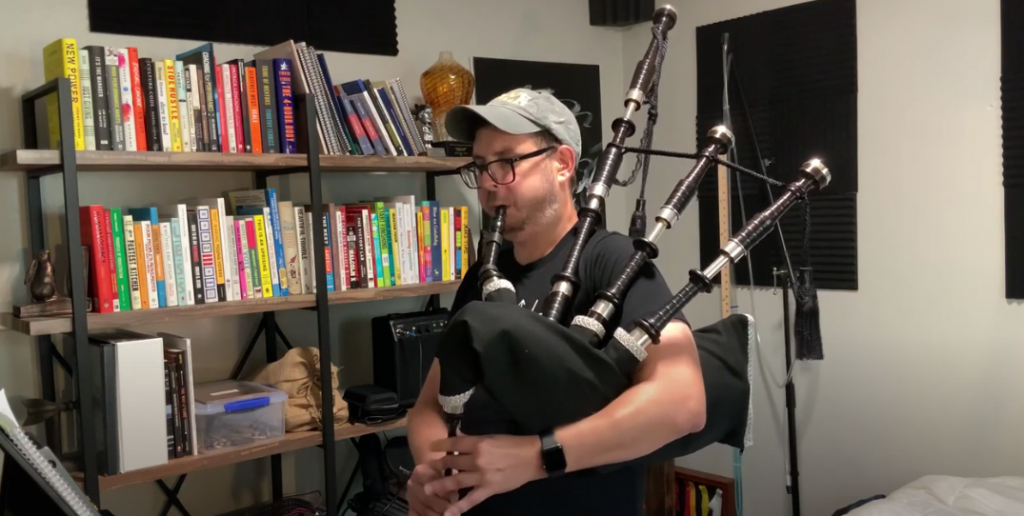The Perfect Dojo Practice Environment and Bagpipe Setup

In order to be successful on your journey towards Bagpipe Freedom, you’re going to need a few things. Nothing here will be a huge surprise, but if you truly want to improve in your playing, it’s time to really make sure your practice space is set up to be 100% functional.
A Distraction-Free Space
One of the biggest killers of learning is distraction. Distractions are everywhere and constant, almost to the point where we’ve forgotten to notice that they are distractions. Here are some examples of distractions that, if they happen during a practice session, will derail you and prevent improvement:
- The biggest one: SmartPhone notifications!
- The second-biggest one: My equipment isn’t set up the way I need.
- The dog is whining.
- The kids need something (help me with my homework! I’m hungry! Can I go to Judy’s house?)
- It’s too cold/hot in here!
- I’m hungry/thirsty!
- Etc.
Just like the first thing someone on a diet should do is clear all junk-food out of the house, the first thing anyone should do who has decided to improve their piping is to set up a space with NO DISTRACTIONS.
Here are some tips:
- Turn your phone on Airplane Mode (with wi-fi turned OFF) whenever you are in your practice room. This way, you can use your metronome and/or your camera, but you won’t get any notifications.
- Set up your space so all necessary gear, devices, and instruments are always set up and ready to go. Nothing distracts/derails faster than not having what you need when you need it.
- Put a sign on the door when you’re practicing to let your family (kids AND spouse) not to bother you when you are practicing. When this rule is violated, get properly angry about this and make it clear it can’t happen again unless it’s a true emergency. I recommend throwing things. Maybe a small pillow.
- Feed your pets and make sure they are fully taken care of before each practice session.
- Feed yourself before each practice session!
- Find a way to climate-control your space consistently, each and every day. If you have to wait a half an hour for things to heat up or cool down, you’ll never get around to focused practice!
- Don’t share your space with anyone! If at all possible, make sure no one else uses your space. This is your functional practice zone, and when others go in there, they are going to mess it up. Then, you can never have the peace of mind to know your practice space is ready for you whenever you need it.
Take some time (yes, actually take some time) to think about practical ways you can transform your practice space into a true distraction free zone. If you want to be successful during our Intensive program, you’re going to need to have your space 100% honed and ready to go.
Important Advice: 2 short practice sessions is way better than one long practice session. Shoot for short, fully focused, distraction-free practice sessions instead of long marathon sessions. In these short periods, you can truly stay distraction-free and truly leverage that focus for great results.
A Recording Device
A recorder is an extremely vital tool for every piper to have and to use. We need to be able to play ourselves back, in high quality, in order to be able to analyze what we did after the fact. Why do we want to analyze our playing after the fact? Well, it’s because while we’re playing we were (hopefully) 100% focused on playing! True analysis can only happen after the fact.
For your Intensive program, you’re going to need a good recorder. Here are some important considerations.
- Your recorder needs to be on a separate device than your metronome (because we will need to use both at once often throughout our program).
- Your recorder needs to be able to adjust its input level to avoid nasty distortion. Most recorders are only designed for voice recording, so when you try to record bagpipes with them, they sound terrible.
- Your recorder should be always ready to go in your practice room - i.e. it should be ultra convenient to use it at a moment’s notice.
For an article outlining everything you should consider about your recording device, click here.
An AMPLIFIED Metronome
Playing with a metronome is a vital element in the bagpipe learning game. But, how do you play with a metronome while also playing your pipes? Typically, the volume of your bagpipes will completely drown out the piddly sound of any metronome, no matter how “good the speaker on it is.”
The best way to do this is to wear headphones connected to your metronome while piping. I do this all the time. It's easy.
But, in order to be able to work with a teacher on your rhythmic playing while using a metronome, or to record yourself piping along with the metronome, things get tricky.
The best way to do this is to amplify the metronome. Click here to read an article all about it.
A Tube-Style Manometer
A manometer is a tool that we use to measure pressure inside of our pipe bag. Click here to learn how to make/acquire your own.
Frequently Asked Question: Can I just use my gauge-style manometer?
Answer: No - to get the full benefit of our teaching methodology, you’ll need the tube-style, and you'll learn more about why when the time comes.
A Mirror!
Wait what? A mirror? Really?
Yes. A mirror is extremely important for any bagpiper to have in their practice space. A mirror allows you to keep an eye on your posture, and on how you hold yourself as a player. You can get an inexpensive tall mirror at any Walmart, Target, Tesco, etc. Make sure you get one and that it gets promptly mounted in your practice space.
“Solid” Internet Connection
Once your physical practice space is set up and you’ve received the workbook, the rest of your materials and tools will all exist on our website.
In order to be successful at the Dojo, your internet connection will need to be “decent.”
Our definition of “decent” is:
- A bare minimum of 5MB/second download speed.
- At least 1MB/second upload speed.
How do you tell how fast your internet is? Simple - just type “test my internet speed” into Google and use any of the free tools that pop up to measure it.
Here’s a screenshot of my current internet speed as I write this:
As you can see, my “Mbps download” (megabytes per second download speed) is 95.4,
And, my “Mbps upload” speed is 11.1
Pretty good! Definitely good for the needs of our course.
Your Bagpipe
For some of us, this could be the first moment where we need to swallow our pride and make a significant adjustment to things in order to make progress. This section will discuss the bagpipe setup we will require for you to use during our program.
To be successful with this Intensive, we need all pipers in the program to adopt a “simple” bagpipe setup, at least for the duration of the course.
A Simple Set Up
What does a “simple” setup mean? Well, it means exactly that!
A simple setup means we don’t add any “contraptions” to our bagpipe to try to “help us.”
That means we should NOT have:
- A water trap (unless we experience extreme moisture while on the plan)
- “Tone Enhancer” valves (or other copy-cat products that attempt to do the same thing)
- Canisters, hoses, or ANYTHING that attaches to the bottom of our stocks inside the bag. (this includes copy-cat products).
- Any sort of desiccant tool or material inside the bag
Also please avoid:
- Complex drone reed designs and/or “moisture absorbent” drone reeds.
- For your reference, drone reeds we recommend include:
- Ezee Drone Reeds and copy-cats
- Kinnaird Reeds and copy-cats
- Canning Reeds and copy-cats
- Selbie reeds
- For your reference, drone reeds we recommend include:
- Cane drone reeds (cane is amazing but not for the scope of this program).
Some “gadgets” that are OK:
- Moose Valves
- “Tone Protector” chanter caps (or copy-cats)
- Split blow-pipe stocks (for eventual insertion of water trap).
Rule of Thumb: The 10 Years Rule
Another thing to consider is that your instrument setup uses modern components. With the possible exception of your bagpipes themselves, your bag, chanter, drone reeds and chanter reeds should all have been manufactured in the last 10 years.
This basic rule of thumb ensures that you’re not unknowingly being held back by out-dated components.
Some common examples of out-dated equipment causing a learning dead-lock:
- A piper is trying to use a chanter from 1990. This doesn’t work because the chanter designed much flatter than modern reeds are designed for (amongst other reasons).
- A piper is using Ezee Drone Reeds from 1995. More often than not, super aged reeds tend to become unstable and less and less reliable over time. It’s time for an update!
- A piper is using an Elk-skin bag from the 1950s (it came with the pipes!). It’s time for a new bag that holds air better and handles moisture better.
- Etc.






Much of the stuff above is a revelation. I've been playing for many years(66) I am on my 2nd set of drones --Robertsons with canning reeds. My 1st were my fathers--Henderson with ivory mounts and cane reeds which I left on the footpath outside Sydney airport in 1976.I never saw them again!! I guess I have learned much over the years but going over the above material has given me a new vision.A lot of modern tech goes over my head so I have to work at it.But I want to be able to be involved in Dojo programs.Wish me well.
Good luck Hamish! Glad you like the stuff above. Even though tech is important, you'll notice that the message is "keep everything as simple as possible so you can focus on the music." Let us know if you need help with simpler tech stuff! 🙂